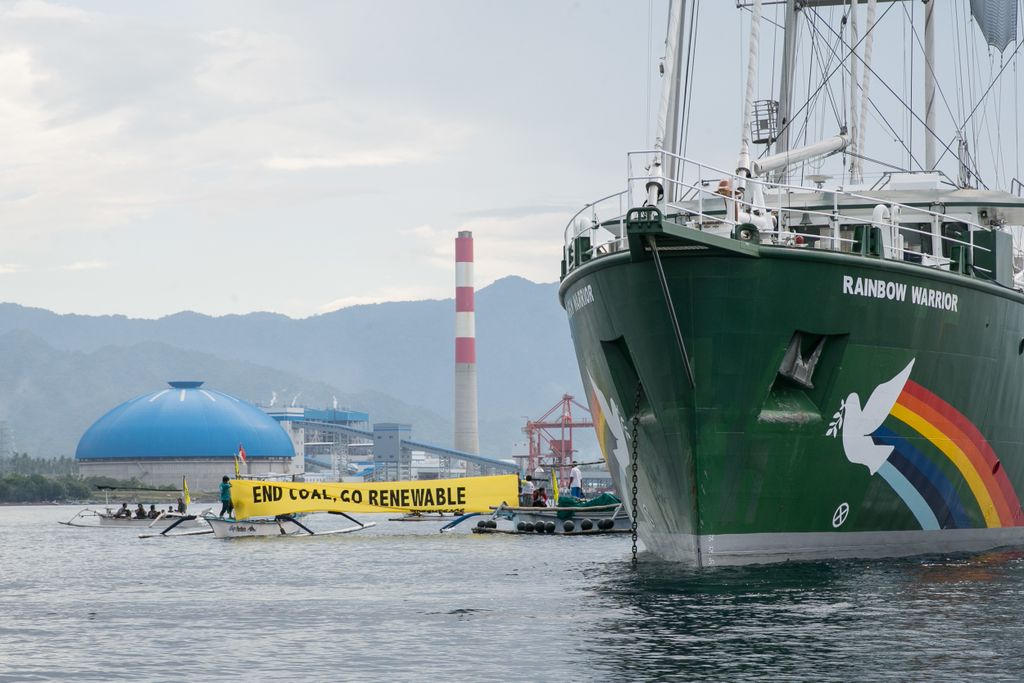The Economy and Stock of Knowledge
On 16 October 2020, I was invited to a discussion about a vital issue: the knowledge-based economy known as the EBP.

Kid carrying a flag reads "Reject Coal Power Plant" during a rally with Greenpeace Rainbow Warrior ship sails as it is accompanied by flotila from local fisherman to reject the development of new coal power plant in Celukan Bawang in Northern Bali. Greenpeace Indonesia and aCelukan Bawang communites file a lawsuit against Bali government that planned to build a new Celukan Bawang Coal Power Plant adding the exist one.
On 16 October 2020, I was invited to a discussion about a vital issue: the knowledge-based economy known as the EBP.
The program was held by the Nationalism Alliance, the Indonesian Rectors Forum, the Indonesian Science Academy and the Indonesian Young Entrepreneurs Association. This topic was nothing new because there have been talks about the EBP for three decades. Economic activities having to do with knowledge have been more intensely undertaken since the prevalence of technology and information (internet) in all aspects of life. When the creative economy entered the vocabulary of economic deliberations, the relevance of knowledge has since been undeniable.
The creative diction is unrelated to conventional factors of production (capital, land and manual labor), but rather it is wholly intertwined with ideas. It is no longer restricted by locations (factories and the like) either, but rather it goes beyond space.
Stages of development
The history of development can be divided into many stages but there are four phases that can provide information about its journey. In the era of mercantilism, which was followed by the period of colonialism and imperialism, welfare was achieved through the control of economic (natural) resources. Those in possession and control of resources had the advantage of wealth accumulation. Economic expansion was conducted by conquest and colonialism was born. Countries with abundant resources initially enjoyed their heyday, but later they were negligent in developing the economy that was devoid of God’s blessing. Consequently, the economy underwent degradation as soon as economic resources were exhausted. So, the resource curse hypothesis and the Dutch disease arose.
Read also: Making Revision Based on Procedure
After the factor was invalidated, economic growth was seen as resulting from the rate of population density. A country with low population density was regarded as having the chance of bringing welfare to its people. The economic activity of a country with high population was at the level of subsistence because of the low man land ratio. However, this was refuted as densely populated countries like Japan and Hong Kong had high per capita income. Brazil and Russia with relatively low population density had lower per capita income than that of Switzerland or Germany.
Technology enables a country to always improve its economic activity to ensure efficiency and more productive operation.
The latest view considers technology a descriptive factor for a country to accumulate wealth and promote economic growth. Technology enables a country to always improve its economic activity to ensure efficiency and more productive operation. This is the basic reference of the century of knowledge-based economy.
Read also: Indonesia Suffers First Recession in over 20 Years, Finmin Says ”Worst is Over”
Apart from this, over the last two decades deeper discourses have been underway about the importance of the factor of institutions as a variable that supports economic growth.
Institutions—unlike the factors of education, resources, population and technology—are seen as capable of explaining the phenomenon of the difference in economic growth achievements between countries. Acemoglu and Robinson (2012) stated that institutions became the most important source to determine the economic failure or progress of a country/nation. A country with inclusive institutions tends to show good economic performance. Conversely, a country with extractive institutions has poor economic performance, such as stagnant economic growth, low productivity and worsening economic prosperity.
Creative destruction
Countries succeeding in combining the EBP with solid institutions have proven to make bright achievements like South Korea and Finland. AT least there are five main characteristics of countries combining the two. First, they construct human character that is oriented to creation rather than imitation. The aim of innovation goes beyond efficiency (in the initial phase). Second, formal and informal education is directed toward increasing the stock of knowledge (depth of the area of study) rather than academic titles. Third, the incentives of innovation institutions are definitely bigger than the rules applied to specialization, within the state, corporations and communities. Fourth, allocations and types of activities in public budget items are altered so as to result in innovations. Fifth, educational and research institutions become the anchor of the economy. They are leading and at the same time directing development.

Greenpeace Rainbow Warrior ship sails as it is accompanied by flotila from local fisherman to reject the development of new coal power plant in Celukan Bawang in Northern Bali. Greenpeace Indonesia and aCelukan Bawang communites file a lawsuit against Bali government that planned to build a new Celukan Bawang Coal Power Plant adding the exist one.
The model of production in the past relied on the division of work/specialization in order to increase manpower productivity. Related to institutions, the most important task to be done for the realization of specialization was the creation of efficient rules of the game (Yeager, 1999). The vital indicator of institutional efficiency could be noticed in the high/low transaction cost. Two ways were normally adopted. First, (formal or informal) regulations were made to guarantee certainty for economic players engaged in transactions. Second, strengthening the system of enforcement in the case of any problem in the transaction process. A low transaction cost would enlarge the market due to increasing demand. Later the greater market push would demand division of work. Eventually, specialization would boost the rate of productivity and become the main source of economic growth (performance).
Such institutions are still important but has increasing lost its relevance since the endogenous technical change theory based on technology and innovation became the backbone of the economy (Maradana et al, 2017). Schumpeter introduced the creative destruction concept to explain the need to “destroy” the old concept and replace it with new creation, especially directed toward seizing opportunities, methods of production and transportation, market designs and new forms of industrial organizations.

The implication is that the operation of institutions in this dynamic approach is different from the case of static growth. Institutions (making rules of the game) in the dynamic approach focus on changing the behavior of
organizations to introduce transformation and technological advancement so that the products turned out become competitive on the market. The important role of institutions is to design rules that make corporations get incentives to carry out the process of “creative destruction”, with the result of new technological inventions and higher economic growth.
Social transformation
Over 25 years ago John Elkington (1994) introduced the triple bottom line (people, planet, and profit) concept. At the time there was also the rising trend of development placing economic growth as a major achievement. The promotion of economic growth as an agenda of development has been widespread since the 1950s so that all countries have made it the sole achievement target. Its outcome wasn’t disappointing, with rocketing economic growth and burgeoning economic prosperity.
Read also: Waiting for the Government Consistency
Yet the lurking problem was soon evident: disparity was spreading and the environment disrupted. Corporations working under the ideological umbrella of economic growth were followed the same principle: accumulating profits. Elkington observed the practice clearly so that he made the declaration of the importance of maintaining the balance of triple-life interests: people (society), universe (environment) and economy (profit).
This concept originally worked at the micro (corporate) level, which was the framework of companies basing their operation on social, environmental and economic implications. The profit concept wasn’t merely meant to be the “financial” aspect but rather the entire benefit of prosperity. The practice at the corporate level was directed at not only profit making but also being committed to environmental conservation and generation of human benefits.
Social and ecological issues have become the basis of production. Corporate performance should be changed, which is not only measured from financial health. Investment efficiency is measured not only from the return on investment (ROI), but also the wider variable, the SROI (social return on investment), and the investor/economic analyst is more focused on the ESG (environmental, social and governance) aspect.
The EBP will in the future be very important to ascertain that affairs related to job creation, equitable distribution of development, economic sovereignty and independence as well as environmental conservation are properly taken care of.
This concept has later been elevated to the macro (state) level: guiding development that is focused on economic, social and environmental achievements. The EBP has the potential to become a new source of disparity if the basis of education and stock of knowledge are not thoroughly regulated, thus only enjoyed by the top layer of society. At this point, the EBP becomes the motivator of social transformation if it’s adaptive to the foundation of development that places humans, the environment and the economy on an equal footing. The EBP will in the future be very important to ascertain that affairs related to job creation, equitable distribution of development, economic sovereignty and independence as well as environmental conservation are properly taken care of.
The inclusive EBP is inevitable and should be strived for in order to secure an economic development model that produces no social wounds and ecological destruction. The understanding of this aspect is important because the basis of the EBP is knowledge-based entrepreneurship (Mortazai and Bahrami, 2012).
Organizational capability
The above narration should be translated into a concrete strategy and action plan so that it can be systematically executed. Among others is the quality preparation of citizens in the form of equitable literacy promotion. The learning process and curriculum should be shifted toward intense “reading capacity” and invention. This homework will be lengthy but it should be done from now on, even it’s now already late. The concept of Merdeka Belajar (Free Learning) launched by the Education and Culture Ministry becomes new room that can be linked with the major goal of the EBP.
Students deepen their learning in their areas of interest and skill. They are subjects receiving facilities for their constant promotion of literacy capacity. They will eventually become creative destruction groups in their respective regions. If this is strongly reflected, inventions will be inevitable in job branches in public and private sectors.
If inventions become a necessity and a new outlook, the orientation and capability of (public and private) organizations should be shifted from concentrating on efficiency to practices that emphasize the opening of room for innovations and the appreciation of inventions. Rules of the game (institutions) are directed at changing the behavior of organizations/corporations so as to broaden the room for innovations and technological advancement.
The culture of research in educational and research institutes are focused on producing inventions that support economic activities. Corporations provide bigger research allocations as investments in innovations as normally practiced in advanced countries. Institutions in the public sector should be deconstructed through a design of flat bureaucratic structure. The distribution of functional resources is more dominant than structural ones.

Ahmad Yustika Erani
The last EBP pillar is the economic network (production, distribution and consumption). The economy operates with its intricacy and increasing contact between players so that it’s impossible to execute without building a network, which establishes connection with various stakeholders, global actors and institutions, and utilizes information technology. Stakeholders have to do with the supporting capacity for the mainstreaming of knowledge, innovations and information technology as the backbone of economic activities. The domestic market is not enough to serve as a leverage in the EBP scheme. A broader market should be covered. The implication is that global actors and institutions become a propellant to set the knowledge-based economy in motion. Investments in information technology should involve all economic players. This entire movement will make knowledge a new creed of the economy.
Ahmad Erani Yustika, Professor, School of Economics and Business, Brawijaya University, and Senior Economist of Indef